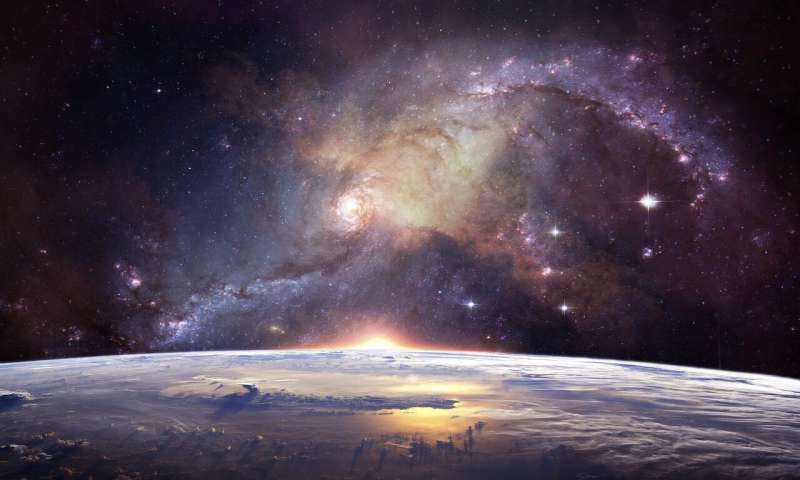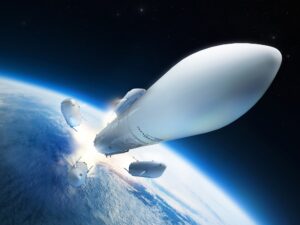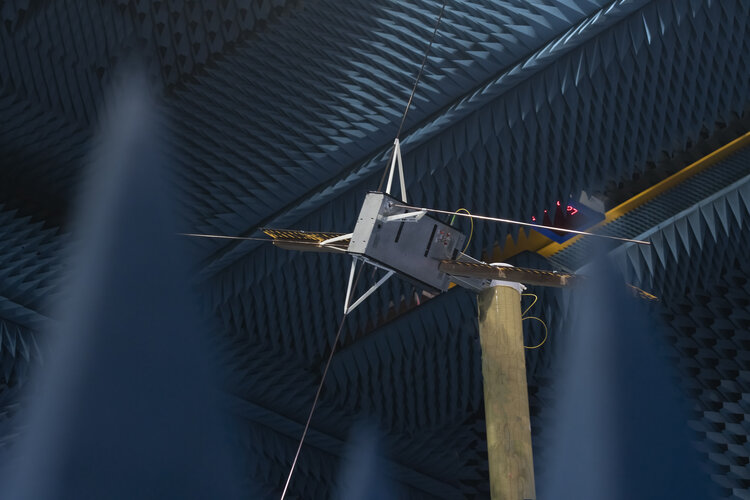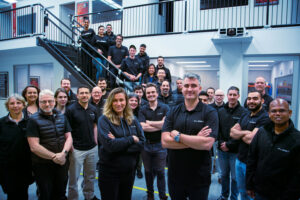Alien organisms: Hitchhikers of the galaxy?
Wednesday, 17 November 2021 13:01
Scientists warn that without good biosecurity measures, 'alien organisms' on Earth may become a reality stranger than fiction.
Published in international journal BioScience, a team of scientists, including Dr. Phill Cassey, Head of the Department of Ecology and Evolutionary Biology at the University of Adelaide, are calling for greater recognition of the biosecurity risks ahead of the space industry.
"In addition to government-led space missions, the arrival of private companies such as SpaceX has meant there are now more players in space exploration than ever before," said Associate Professor Cassey. "We need to take action now to mitigate those risks."
Space biosecurity concerns itself with both the transfer of organisms from Earth to space (forward contamination) and vice-versa (backward contamination). While the research points out that at present the risk of alien organisms surviving the journey is low, it's not impossible.
Dr. Cassey said: "Risks that have low probability of occurrence, but have the potential for extreme consequences, are at the heart of biosecurity management. Because when things go wrong, they go really wrong."
The research provides clear evidence of how humans have spread organisms to the remotest regions of the earth and sea, and even into space.
China silent, South Korea ‘concerned’ over debris created by Russia’s anti-satellite missile test
Wednesday, 17 November 2021 12:10
South Korea’s foreign ministry expressed concern over the “numerous pieces of debris” created in low Earth orbit when Russia destroyed a Soviet-era satellite with a missile strike earlier this week but stopped short of criticizing Russia.
Arianespace to launch Australian Optus-11 on Ariane 6
Wednesday, 17 November 2021 11:58
Arianespace has secured a contract with Australian operator SingTel Optus to launch the Optus-11 communications satellite using Ariane 6 in 2023.
Satellite attack: the mounting arms race in space
Wednesday, 17 November 2021 09:38 Last year a US general made an ominous revelation: two Russian satellites in orbit were stalking a US spy satellite high above the earth.
It wasn't clear if the Cosmos satellites could attack USA-245, an American surveillance spacecraft.
"It has the potential to create a dangerous situation in space," said General Jay Raymond, head of the Pentagon's Space Command.
The incident passed
Last year a US general made an ominous revelation: two Russian satellites in orbit were stalking a US spy satellite high above the earth.
It wasn't clear if the Cosmos satellites could attack USA-245, an American surveillance spacecraft.
"It has the potential to create a dangerous situation in space," said General Jay Raymond, head of the Pentagon's Space Command.
The incident passed Testing mini-radar to peer inside asteroid
Wednesday, 17 November 2021 08:10 Image:
Testing mini-radar to peer inside asteroid
Image:
Testing mini-radar to peer inside asteroid AFRL awards $1b contract to Space Dynamics Laboratory
Wednesday, 17 November 2021 06:58 The Air Force Research Laboratory (AFRL) has awarded its largest-ever contract for space-related technology development and mission support.
The contract, worth up to $1B, was awarded to Utah State University Space Dynamics Laboratory (USU/SDL) a University Affiliated Research Center (UARC) to ensure an essential engineering, research, and development capability, provided by an educational
The Air Force Research Laboratory (AFRL) has awarded its largest-ever contract for space-related technology development and mission support.
The contract, worth up to $1B, was awarded to Utah State University Space Dynamics Laboratory (USU/SDL) a University Affiliated Research Center (UARC) to ensure an essential engineering, research, and development capability, provided by an educational Russia says S-550 more efficient at intercepting ICBMs than THAAD and Aegis
Wednesday, 17 November 2021 06:58 The new air defence system is being developed on the basis of the advanced S-500 Prometey (Prometheus), designed to destroy enemy targets within a range of around 600 kilometres (370 miles).
Russia's S-550 will become the world's first mobile special operation missile and airspace defence system capable of effectively destroying intercontinental ballistic missiles (ICBM), two sources in th
The new air defence system is being developed on the basis of the advanced S-500 Prometey (Prometheus), designed to destroy enemy targets within a range of around 600 kilometres (370 miles).
Russia's S-550 will become the world's first mobile special operation missile and airspace defence system capable of effectively destroying intercontinental ballistic missiles (ICBM), two sources in th US calls Russian anti-satellite missile test reckless, irresponsible
Wednesday, 17 November 2021 06:58 The United States on Monday called a Russian anti-satellite missile test "reckless" and "irresponsible" after debris from the test endangered astronauts working aboard the International Space Station.
The seven astronauts were forced to take shelter in their space capsules as a cloud of space junk moved toward the station at high speeds.
While the debris eventually moved away from th
The United States on Monday called a Russian anti-satellite missile test "reckless" and "irresponsible" after debris from the test endangered astronauts working aboard the International Space Station.
The seven astronauts were forced to take shelter in their space capsules as a cloud of space junk moved toward the station at high speeds.
While the debris eventually moved away from th US Space Force contracts Lockheed Martin for three more GPS IIIF satellites
Wednesday, 17 November 2021 06:58 The U.S. Space Force exercised its second contract option valued at approximately $737 million for the procurement of three additional GPS III Follow On (GPS IIIF) space vehicles (SVs) from Lockheed Martin on October 22, 2021.
This contract option is for GPS IIIF space vehicles 15, 16 and 17 (SV15-17).
GPS IIIF satellites build off the innovative design of Lockheed Martin's next gene
The U.S. Space Force exercised its second contract option valued at approximately $737 million for the procurement of three additional GPS III Follow On (GPS IIIF) space vehicles (SVs) from Lockheed Martin on October 22, 2021.
This contract option is for GPS IIIF space vehicles 15, 16 and 17 (SV15-17).
GPS IIIF satellites build off the innovative design of Lockheed Martin's next gene US accuses Russia of generating orbital debris after 'destructive' satellite test, vows to respond
Wednesday, 17 November 2021 06:58 The United States has accused the Russian Federation of conducting a "destructive satellite test" that could put astronauts, cosmonauts, and global satellite operations at risk.
Through the U.S. State Department's spokesperson, Ned Price, it was revealed that the alleged test was conducted early Monday. Price went on to condemn the action, calling it "reckless."
The test was describe
The United States has accused the Russian Federation of conducting a "destructive satellite test" that could put astronauts, cosmonauts, and global satellite operations at risk.
Through the U.S. State Department's spokesperson, Ned Price, it was revealed that the alleged test was conducted early Monday. Price went on to condemn the action, calling it "reckless."
The test was describe Space Force, Georgia Tech partner on STEM education, innovation
Wednesday, 17 November 2021 06:58 The US Space Force established an agreement with the Georgia Institute of Technology Nov, 11, making Georgia Tech the latest entrant into the Space Force's University Partnership Program.
Lt. General Nina M. Armagno, U.S. Space Force director of staff, joined Georgia Tech Provost Steven W. McLaughlin and Executive Vice President for Research Chaouki T. Abdallah to sign the agreement. The s
The US Space Force established an agreement with the Georgia Institute of Technology Nov, 11, making Georgia Tech the latest entrant into the Space Force's University Partnership Program.
Lt. General Nina M. Armagno, U.S. Space Force director of staff, joined Georgia Tech Provost Steven W. McLaughlin and Executive Vice President for Research Chaouki T. Abdallah to sign the agreement. The s L3Harris to upgrade Space Force counter-communications via $125M contract
Wednesday, 17 November 2021 06:58 L3Harris Technologies received a $125 million multi-year contract to produce space electronic warfare systems that safeguard U.S. military operations and warfighters.
Under the Meadowlands production program, L3Harris will upgrade 16 Block 10.2 versions of Counter-Communications Systems (CCS) operating in Peterson Space Force Base, Colo., Vandenburg Space Force Base, Calif., Cape Canaveral
L3Harris Technologies received a $125 million multi-year contract to produce space electronic warfare systems that safeguard U.S. military operations and warfighters.
Under the Meadowlands production program, L3Harris will upgrade 16 Block 10.2 versions of Counter-Communications Systems (CCS) operating in Peterson Space Force Base, Colo., Vandenburg Space Force Base, Calif., Cape Canaveral Northrop Grumman meets first-stage rocket motor milestone for Ground Based Strategic Deterrent Program
Wednesday, 17 November 2021 06:58 Northrop Grumman met a key manufacturing milestone in August, successfully performing the first insulation and case wind of the Ground Based Strategic Deterrent (GBSD) first-stage solid rocket motor.
"Working closely with the Air Force and nationwide team of industry partners, we continue to make progress to modernize the country's aging intercontinental ballistic missile system," said Ste
Northrop Grumman met a key manufacturing milestone in August, successfully performing the first insulation and case wind of the Ground Based Strategic Deterrent (GBSD) first-stage solid rocket motor.
"Working closely with the Air Force and nationwide team of industry partners, we continue to make progress to modernize the country's aging intercontinental ballistic missile system," said Ste Fleet Space raises $26.4 million in Series B round
Wednesday, 17 November 2021 02:48
Fleet Space Technologies raised $26.4 million in a Series B investment round that puts a value of $126 million on the Australian internet-of-things satellite constellation.
Nelson and Rogozin talk about ASAT test
Wednesday, 17 November 2021 00:49
NASA Administrator Bill Nelson spoke with his Russian counterpart a day after a Russian antisatellite test, as others in the Russian government dismissed the threat to space sustainability that test created.

